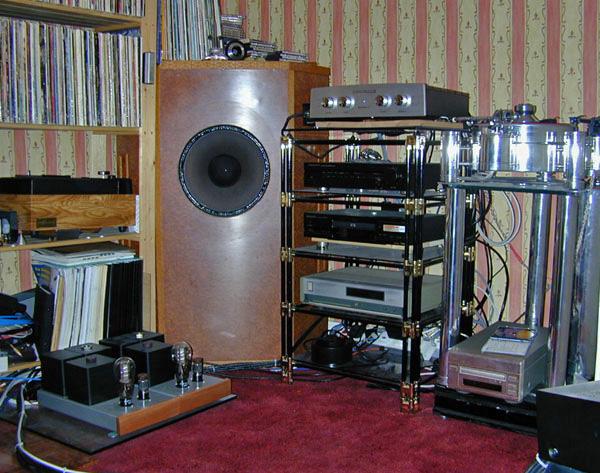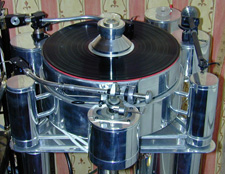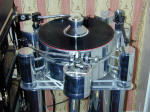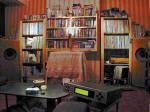-edible zone-
(click thumbnail for full size image)
 1
1
 4 (click thumbnail for full size image)
4 (click thumbnail for full size image)
--Picture Notes:
- view of system rack, turntable and right hand speaker
- view of my living room in "listening" mode from near the listening position, EQ near the listening seat on the couch
- view of the Turntable, affectionately known as "The Three-Armed Monster"
- External view of transformer passive linestage
- Internal view of the transformer passive linestage
___________________________________________horizontal rule
--Equipment:
Turntable: Acoustic Solid "Solid One" on Acoustic
Solid Stand
which stands on an
homebuild Symposium style
isolation platform which
in turn is on homebuild
String
Suspension Concept "SSC" isolators.
Three Arm/Pickup combos are
mounted, right now they
are:
1) For modern records, audiophile
re-pressings ect.
Origin Live Silver 250 with Goldring Elite MC
2) For most older pressings down to around 1970 etc.
SME 3009 MKII
with Denon DL-103
3) For very old pressings (pre 1970's) and most
older Decca/DGG and sublabel classical etc.
Ortofon RS-212 Special
with Ortofon SPU-GTE
CD Player: Philips LHH-1000 DAC (nee Marantz
CD/DA-12) restored
and upgraded
(Op-Amp's, Capacitors etc.)
with a Pioneer DV-505 DVD Player (modified) a
Transport,
also
Heart/Marantz CD-6000 as Transport
Preamplifier: Opera Audio
Consonance Reference 1.2
(modified - especially the MC Stepup
Transformer and
two phono inputs fitted)
or DIY l'Pacific Solid
State Phonostage (J-Fet,
passive EQ, Zero Feedback)
and
Transformer Volume Control (TVC) based passive
preamp.
A new
LCR eqalised Phonostage (E810F, 600 Ohm
passive LCR RIAA, EC8020) is
being
build right now.
Equaliser: Behringer Ultracurve 8024
(modified Op-Amp's,
Capacitors, Output Transformers) on small
Hostess Trolley style "rack", to be placed at the
listening position
for "critical"
listening
Amplifier: "The Hylo Idealistic
Single Ended 300B Amplifier"
an ever evolving concept on the chassis
of the
DIY-HiFisupply Billie Chassis
currently configured WE 437A
Driver, TJ "Mesh" 300B
(or WE or Svetlana),
WE 274A Rectifier
A pair of Loftin White Monoblocks based on the
Original Design
(UX-224, UX-245, RCA 5R4GY)
is being build slowly.
Speakers:
Tannoy Monitor Red 15 Inch Dual Concentric Drivers
in Corner York
enclosure build
by a friend from Tannoy Plans in 1" Solid Wood,
original crossovers, drivers C37
lackquered and dustacp removed.
Previously used
supertweeters removed from system
Music: Much
Jazz and Blues, a lot of music from the Age of
Enlightenment
(Haendel, Vivaldi et al),
some modern US and Russian classical
composers
(Copland and Shostakovitsh especially),
Soul/Funk/Rap,
Electronica, Easy Listening, lyrical
rock, hard rock, Metal, World
Music
Photos taken by Adnan Arduman, slightly outdated. New ones
soon.
My system is aimed primarily at allowing me to enjoy a huge
range of music
from Vinyl Records of all sorts of ages and
providence. It is not optimised
to excell in any specific area, but
is weighted towards a natural, "live"
type of presentation, with an
emphasis on realistisc Sound Pressure Levels,
strong dynamic and pace
and realistic tonality.
As over the years that are included in
my collection many changes occured,
from wide swings in style rake
angle, groove wall angle, the use or absence
of tracing distortion
compensators and so on, I have found that using
several cartridges
with stronly varying charateristics seems best.
The records
pressed from the late 1960's all the way through the 1970's tend
to
have used a tracing simulator during cutting and thus require a pickup
with a conical stylus (I use a Denon DL-103) to work correctly, though
gentle elliptical stylli cuts like the one used on the Ortofon SPU-GTE
also
seem to work from a subjective point. Recordings mastered before
the
widespread use of tracing simulators (generally before the late
1960's) tend
to sound best to my ears on the old SPU-GTE, maybe not
unrelated to the fact
that the QC listening at the factory would have
likely included exactly such
a pickup. Modern pressings from around
the late 1970's/early 1980's onwards
tend to have a pretty uniform
SRA and groove wall angel, thus allowing the
theoretical superiority
of line contact stylii to be leveraged effectively,
so most of such
LP's tend to be played with the "modern" combination, though
depending on recording and mood I may choose one of the others too,
there is
no dogma to the use of pickups.
Equally, first, but
not solely corrects the Room and Speaker related
problems (primarily
the room modes at low frequencies and the well
documented midrange
"hump" for the older (pre Monitor Gold) Tannoy Driver.
Also, my room
is a little asymmetric which again is corrected by the
equaliser. I
have further programmed some "psychoacoustic" overlay curves
based on
a range of research, especially however that by Mr. Jens Blauert
from
Germany, a piece of very neat understanding how frequency response
manipulation affect our spatial perception. Here a little narrow boost
in
some ranges to the tune of 1 to 3db and a little broadband cuts in
others to
the tune of -0.5 to -1.5db can make the difference between
a percieved
exceptionally wide and deep soundstage and one that is
flat and unlayered.
Sadly this research is not widely known or
publicised, especially in the
audiophile press, a shame as it would
often ease the corelation of measured
speaker response and percieved
spatiality.
Beyound all that however I have programmed the
essential corrections for
several widely used cutting Equalisers when
replayed via a RIAA equalised
Phonostage (the deviations may reach as
much as 10db at very low
frequencies). More specifically, the Decca
EQ as used by Telfunken, Teldec,
Decca and Deutsche Gramophone
Gesellschaft, the Columbia EQ used by
Columbia/CBS et al and the CCIR
EQ used by some European (especially eastern
europe) are covered at
the moment by my presets. Further of course I tend to
adjust for what
I percieve as tonal flaws in the Recording, if such are
present.
Using the EQ in "restorative" mode on suchg things as the Film
soundtrack from "The Wizad of Oz" or very bad sounding recordings, such
as
the "Beginnings" Live session of Chicago (then still known as
Chicago
Transit Authority) can be amazing. For example it is possible
to cut through
"muddy" sound and bring voclas clearly into focus,
make the drumkit and
percussion audible through the wall of guitar
sound on the Chicago LP.
To me at least the use of an Eqauliser
is not optional in a high performance
audio system, any more than I
could accept the notion of a single Arm/Pickup
combo that gives the
best results regardless of vintage and providence of
the actual LP.
In order to keep alive the great cultural heritage of mankind
embodied by old LP's and in order to appreciate the Music fully I feel
that
an approach a little more baroque and a little less calvinist,
minimalist
and masochist than that preached by the High End press and
practiced sadly
by far too many people, is essential.
Ciao T



